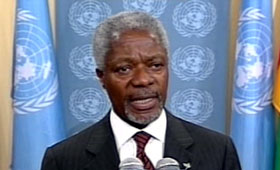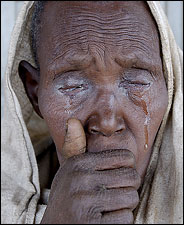November 1, 2006 a day of protest against tyranny (more on this below)
06/06/2005 Ethiopian police surrounded two university campuses in Addis Ababa as hundreds of students defied a government ban on demonstrations to protest undemocratic - one party rule in Ethiopia. "Enough is enough," yelled out students, "Get up, stand up - stand up for your flag." Chanted the students to the tune of legendary reggae singer Bob Marley
------------------------------------------------
-KIL press release Oct 16
-Major Yoseph Yazew Press release Oct 15
------------------------------------------------
Internal opposition in a fray
Indian Ocean Newsletter N° 1198 14/10/2006
 While the leadership of the Coalition for Unity and Democracy Party (CUDP) in the Diaspora is paralysed by a deep internal crisis, the situation is no better for the opposition within Ethiopia itself. Two of its leaders still free, former members of the United Ethiopian Democratic Force (UEDF), are pulling in different directions.
While the leadership of the Coalition for Unity and Democracy Party (CUDP) in the Diaspora is paralysed by a deep internal crisis, the situation is no better for the opposition within Ethiopia itself. Two of its leaders still free, former members of the United Ethiopian Democratic Force (UEDF), are pulling in different directions. Merera Gudina of the Oromo National Congress (ONC) and Beyene Petros of the Southern Ethiopian People’s Democratic Coalition (SEPDC) no longer have the same political approach. According to sources close to the government, Merera Gudina has tried to persuade Beyene Petros to campaign with him to put the freeing of the imprisoned opposition leaders into a central place on the agenda of the new parliamentary session.
 Beyene Petros and Bulcha Demeksa are believed not to have accepted to follow Merera Gudina on this path, whereas Lidetu Ayalew is reported to not even have been contacted. Since then, the Ethiopian government has stepped up the pressure on Merera Gudina, with measures including freezing his personal bank account. For their part, some EPRDF newspapers have accused Merera Gudina and several CUDP MPs who accepted to take up their seat in Parliament of having plotted to “disrupt the work of Parliament”.
Beyene Petros and Bulcha Demeksa are believed not to have accepted to follow Merera Gudina on this path, whereas Lidetu Ayalew is reported to not even have been contacted. Since then, the Ethiopian government has stepped up the pressure on Merera Gudina, with measures including freezing his personal bank account. For their part, some EPRDF newspapers have accused Merera Gudina and several CUDP MPs who accepted to take up their seat in Parliament of having plotted to “disrupt the work of Parliament”. However, according to a source close to Mereru Gudina, the latter’s disagreement with Beyene Petros broke out when the latter asked him to publish on behalf of the internal wing of the UEDF, a joint communiqué denouncing the Ethiopian People’s Revolutionary Party (EPRP, radical faction of the UEDF, influential among the Ethiopian Diaspora). Merera Gudina refused and Beyene Petros finally released the communiqué in the name of the SEPDC alone.
UN says Eritrea moving troops closer to Ethiopia
 UNITED NATIONS, Oct 16 (Reuters) - The United Nations accused Eritrea on Monday of moving soldiers and tanks closer to Ethiopia in violation of a six-year-old peace agreement ending a border war between the two Horn of Africa neighbors.
UNITED NATIONS, Oct 16 (Reuters) - The United Nations accused Eritrea on Monday of moving soldiers and tanks closer to Ethiopia in violation of a six-year-old peace agreement ending a border war between the two Horn of Africa neighbors.Eritrea has moved some 1,500 troops and 14 tanks into a buffer zone set up along its border with Ethiopia, and has also taken over a U.N. checkpoint, U.N. chief spokesman Stephane Dujarric said.
Secretary-General Kofi Annan "urges the government of Eritrea to withdraw its troops from the zone immediately, and to cooperate with the United Nations in restoring the cease-fire arrangements," Dujarric said.(More...)
US military consolidates Africa command
Direct US arms sales to East Africa and the Horn of Africa countries—Djibouti, Eritrea, Ethiopia, Kenya, Rwanda Uganda and Zambia--have increased from under one million dollars in 2003 to over $25 million in 2006. Djibouti leads the list with nearly $20 million in direct arms purchases in 2005 and 2006.
However, Ethiopia also shows a dramatic increase of arms purchases. In 2006, an estimated eight million dollars of weapons will be directly sold and with another five million dollars estimated in 2007. This is an increase from only $250,000 in 2005 and $750,000 in 2003.
Strategically, the US military has developed a regional operations plan that centers on Djibouti to support the Horn countries. It anchors the southern flank with bases in Kenya, Zambia and Uganda to the west.
The US strategy in East Africa and the Horn is strategically positioned in two areas. First, it can immediately assist Kenya if the fighting in Somalia spills over into Northern Kenya. For the past month, a steady stream of Somalia refuges have crossed into Kenya challenging the drought stricken region further and increasing tensions between Kenya and Somalia.
Second, like in Nigeria, it can be used to ensure an uninterrupted flow of oil from the newly discovered fields of Uganda and Kenya, and it opens the door to the construction of a well-protected oil pipeline carrying oil for the interior of Central Africa to the port of Mombasa. It also provides a strategically located airbase to support future military operations to the north in Sudan or to the west.(More...)
November 1, 2006 a day of protest against tyranny in Ethiopia
PR from KIL
Let’s remember those killed, maimed and imprisoned a year ago on November 1, 2005. Let us all join the worldwide day of protest organized to renew our resistance against tyranny. Preparation is underway in Europe, Africa, Canada and North America. Look out for details. Be part of the struggle for freedom, democracy and unity in Ethiopia.
KIL and World Wide Kinijit support call on other parties and civic societies to join us.(Read entire press release)
The difficult profession of journalist
Indian Ocean Newsletter N° 1198 14/10/2006
After a first spate of Ethiopian journalists from the independent press leaving the country, it is now the turn of those working for the State media to scarper. Ezedine Kedir, who worked for the Ethiopian government television station, has just set up home in Germany.
This brings the number of journalists from government media defecting up to sixteen. According to information we have received, Alemneh Wassie, who worked for Radio Fana owned by the Tigray People’s Liberation Front (TPLF) has also left the country with his family to settle in Israel. Journalists in government media who are reluctant to apply the orders of the authorities in Addis Ababa sometimes receive death threats, pushing them to leave the country.
Ethiopian, government troops briefly occupy Somali town, residents say
BAIDOA, Somalia – Ethiopian troops alongside government forces entered a southern Somali town Sunday, residents said, in a move likely to further strain tensions with Islamic radicals who are tightening their grip on the war-ravaged country.
Well-armed troops aboard seven trucks mounted with machine guns arrived in the agricultural town of Dinsor, witnesses said. The forces then left, residents told The Associated Press.
“They were telling us that they were in control and not to worry,” shopkeeper Mohamed Abdi Salam told the AP by telephone.(More...)
Africa's Lagging Development-'Why Are They Poor?' [PART 3]
by Jason Beaubien
 (This series examines how armed conflict, poor agricultural practices, disease, lousy governments and foreign trade practices contribute to making Africa the poorest continent in the world.)
(This series examines how armed conflict, poor agricultural practices, disease, lousy governments and foreign trade practices contribute to making Africa the poorest continent in the world.)Solutions to Africa's Food Woes Remain Elusive
Sub-Saharan Africa is waiting for a Green revolution. Agricultural movements in Asia and Latin America in the later part of the 20th century dramatically boosted crop yields, allowed countries to feed growing populations and spurred economic growth.
But sub-Saharan Africa still doesn't produce enough food to feed its own people. Millions of Africans are chronically malnourished, and the region has become perennially dependent on international food aid.
The majority of Africans earn their livings through agriculture, most as subsistence farmers. And African soil is some of the least productive in the world.
In Western Tanzania, herders graze small Zebu cattle. The herds of stocky, almost-miniature cows migrate across the plains of the Rift Valley. The animals can survive in what is at times a harsh, semi-arid environment, but they don't produce nearly as much milk or beef as Western breeds.
Sedentary farmers in the area grow mainly sorghum and maize. Corn production, however, is erratic. Some of the small plots have rows of tall, sturdy corn plants. Others are dusty expanses of failed crops.
Amelio Nande says he gets less and less food each year from his five-acre field. He says the land has become less productive mainly because of drought.
Nande grows corn and a little bit of rice. He says he keeps most of his crop to feed his family. He sells a portion of his harvest at the local market. This is his only source of cash. So the drop in productivity of his land directly affects his family's income. But he says there's little he can do about it.
If you put fertilizer here, he says, it will burn the plants. He also doesn't rotate his crops. There's no irrigation. And Nande believes the amount he harvests is entirely dependent on rainfall.
In much of sub-Saharan Africa, most subsistence-farmers operate this way. They use simple techniques that haven't changed for generations.
As nutrients get leeched from the soils and Africa's population grows, the gap between the amount of food produced and the amount needed grows wider.
Mark Rosegrant with the International Food Policy Research Institute says a solution to Africa's overall food problems is still a long way off.
"When we look at long-term projections in Africa, there's still going to be a period where imports are going to be increasing substantially," he says. "So they're going to be relying on increased market imports. But also I think inevitably there's going to be still a considerable need for concessionary- and food aid-type imports of food."
And Rosegrant says unless there are significant policy shifts, the need for food aid and the number of malnourished Africans will increase in the coming decades.
Today's Top Stories
-Somali president in Ethiopia to discuss security situation-Official: Saddam verdict coming Nov. 5
-Israel's President May Stand Trial
-Vatican officially confirms Pope trip to Turkey
-Grisham: 'I hope this book makes people think'
-New York's punk shrine tunes out after 33 years
No comments:
Post a Comment